
Dutchess County is a county in the U.S. state of New York. As of the 2020 census, the population was 295,911. The county seat is the city of Poughkeepsie. The county was created in 1683, one of New York's first twelve counties, and later organized in 1713. It is located in the Mid-Hudson Region of the Hudson Valley, north of New York City.

Milan is a town in Dutchess County, New York, United States. The town is in the northern part of the county and is very rural. As of the 2020 census it had a population of 2,245, slightly down from 2,370 in 2010. Milan is located approximately 90 miles (140 km) north of New York City, 60 miles (97 km) south of Albany, and 150 miles (240 km) west of Boston. It is bordered by Rhinebeck and Red Hook to the west, Pine Plains to the east, Stanford to the southeast, Clinton to the south, and Gallatin to the north by Columbia County. The only major route in the town is the historic Taconic State Parkway, though NY 199 serves as the main local thoroughfare.

Tivoli is a village in Dutchess County, New York, United States. The population is 1,012, according to the 2020 census. The village, which was incorporated in 1872 from parts of Upper Red Hook Landing and Madalin, is the northernmost settlement in the county, located in the northwestern part of the town of Red Hook. It is part of the Poughkeepsie–Newburgh–Middletown, NY Metropolitan Statistical Area as well as the larger New York–Newark–Bridgeport, NY-NJ-CT-PA Combined Statistical Area. It is entirely within the Hudson River Historic District, a National Historic Landmark. The village is accessible via New York State Route 9G at an intersection with Dutchess County Route 78.

Rhinebeck is a village in the town of Rhinebeck in Dutchess County, New York, United States. The population was 2,657 at the 2010 census. It is part of the Poughkeepsie–Newburgh–Middletown, NY Metropolitan Statistical Area as well as the larger New York–Newark–Bridgeport, NY-NJ-CT-PA Combined Statistical Area.

A diner is a small, inexpensive restaurant found all over the United States, as well as in Canada and parts of Western Europe. Diners offer a wide range of foods, mostly American cuisine, a casual atmosphere, and, characteristically, a combination of booths served by a waitstaff and a long sit-down counter with direct service, in the smallest simply by a cook. Many diners have extended hours, and some along highways and areas with significant shift work stay open for 24 hours.
New York State Route 199 is a 30.91-mile-long (49.74 km) state highway located in the Hudson Valley of the U.S. state of New York. Its western end is in Ulster County, where it begins as the continuation of the short U.S. Route 209 expressway east of its interchange with U.S. Route 9W; after crossing the Kingston–Rhinecliff Bridge over the Hudson River the rest of the highway crosses northern Dutchess County. As it does it passes through downtown Red Hook and Pine Plains, reaching its eastern end at U.S. Route 44 and State Route 22 southwest of Millerton in the upper Harlem Valley.
New York State Route 308 (NY 308) is a short state highway, 6.19 miles (9.96 km) in length, located entirely in northern Dutchess County, in the U.S. state of New York. It is a major collector road through a mostly rural area, serving primarily as a shortcut for traffic from the two main north–south routes in the area, U.S. Route 9 (US 9) and NY 9G, to get to NY 199 and the Taconic State Parkway. The western end of NY 308 is located within Rhinebeck's historic district, a 2.6-square-mile (6.7 km2) historic district comprising 272 historical structures. The highway passes near the Dutchess County Fairgrounds, several historical landmarks, and briefly parallels the Landsman Kill.
U.S. Route 9 (US 9) is a part of the U.S. Highway System that runs from Laurel, Delaware, to Champlain, New York. In New York, US 9 extends 324.72 miles (522.59 km) from the George Washington Bridge in Manhattan to an interchange with Interstate 87 (I-87) just south of the Canada–United States border in the town of Champlain. US 9 is the longest north–south U.S. Highway in New York. The portion of US 9 in New York accounts for more than half of the highway's total length.

The Agawam Diner is an historic diner at 166 Newburyport Turnpike in Rowley, Massachusetts. Manufactured in 1954, it was moved to this location in 1970 after first being located in Ipswich. It is the town's only diner, and one of only six in the state manufactured by the Fodero Dining Car Company. It was listed on the National Register of Historic Places in 1999.
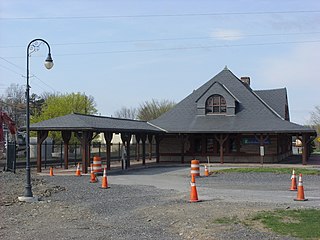
Union Station served the residents of Chatham, New York, from 1887 to 1972 as a passenger station and until 1976 as a freight station. It was the final stop for Harlem Line trains. It had originally served trains of the Boston and Albany Railroad, then the New York Central Railroad and the Rutland Railway. It served as a junction for service that radiated to Rensselaer, New York, to the northwest; Hudson, New York, to the southwest; Vermont, to the northeast, and Pittsfield, Massachusetts and New York City, to the south.
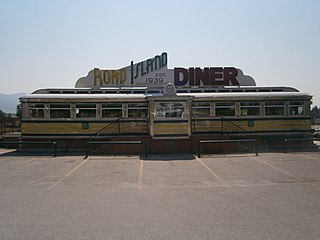
The Road Island Diner is a rare classic Streamline Moderne 60' x 16' Art Deco diner car restaurant located in the remote mountain city of Oakley, Utah in the United States. It was prefabricated as diner # 1107 in 1939 at the Elizabeth, New Jersey factory of the Jerry O'Mahony Diner Company.
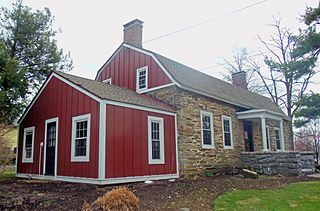
The Bergh–Stoutenburgh House is located on U.S. Route 9 opposite Mansion Drive in Hyde Park, New York. It is currently used as a district office by state senator Sue Serino.
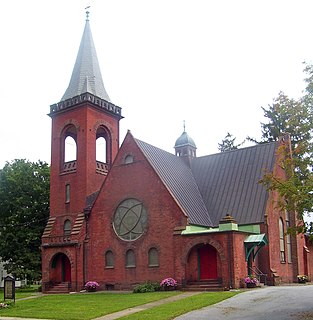
St. Paul's (Zion's) Evangelical Lutheran Church is the official name of what is usually referred to as St. Paul's Lutheran Church in Red Hook, New York, United States. Its six buildings and cemetery are on a 15-acre (6.1 ha) lot on South Broadway just south of the village center. The current church is the third building on a spot that has been home to what was originally a Reformed congregation since 1796.

The Elmendorph Inn, is the oldest building in the village of Red Hook, New York, United States. It is located at the north corner of North Broadway and Cherry Street, a block north of the junction of Route 9 and NY 199.
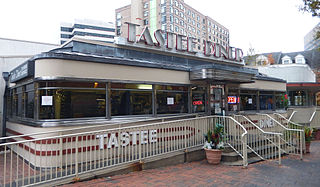
Tastee Diner is a small franchise of diners in the suburban Washington, D.C. area established in 1935. There are three Tastee Diner locations in the US state of Maryland: Bethesda, Laurel, and Silver Spring. Tastee Diner serves a wide variety of authentic American food, with a heavy emphasis on breakfast, and pie. Their restaurants are all open twenty-four hours a day, seven days a week.

Tanpopo Ramen and Sake Bar is a historic diner in Albany, New York, built in 1941 and located at 893 Broadway, one of the oldest streets in Albany. Used as a set for the 1987 film Ironweed, which starred Jack Nicholson and Meryl Streep, it was added to the U.S. National Register of Historic Places in 2000.

The Hendrick Martin House is located on Willowbrook Lane in the town of Red Hook, New York, United States, just north of the eponymous village. It is a stone house built in two phases in the mid- and late 18th century. In 2007 it was listed on the National Register of Historic Places.

Silk City Diners was a division of the Paterson Wagon Company, later known at Paterson Vehicle Company, established by Everett Abbott Cooper and based in Paterson, New Jersey, which produced about 1,500 diners from 1926 until 1966. Each was tagged with the year and order in which it was built; for example, 5607 would be the seventh diner manufactured in 1956. Several have been listed on the National Register of Historic Places (NRHP).

The Saw Kill is a 14.3-mile-long (23.0 km) tributary of the Hudson River, called the Metambesem by the Algonquin people of the area and sometimes called Sawkill Creek today. It rises in the town of Milan and drains a 22-square-mile (57 km2) area of northwestern Dutchess County, New York, that includes most of the town of Red Hook to the west and part of Rhinebeck to Red Hook's south.






















